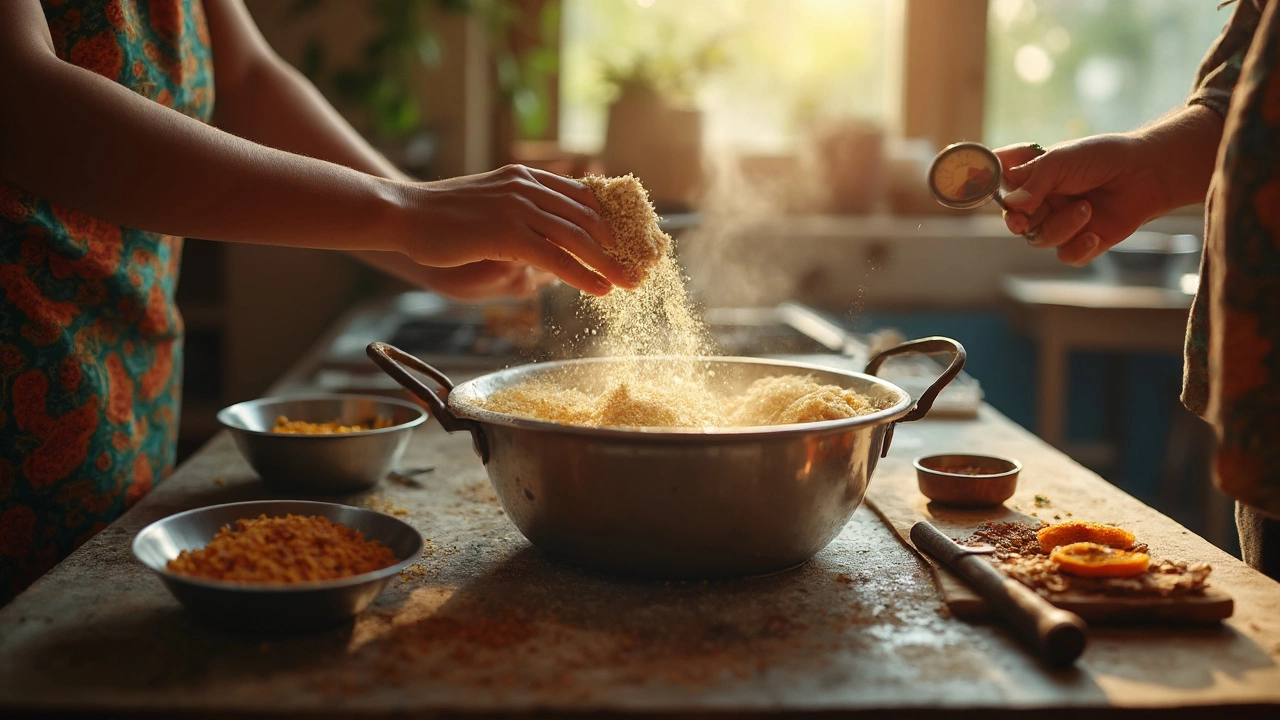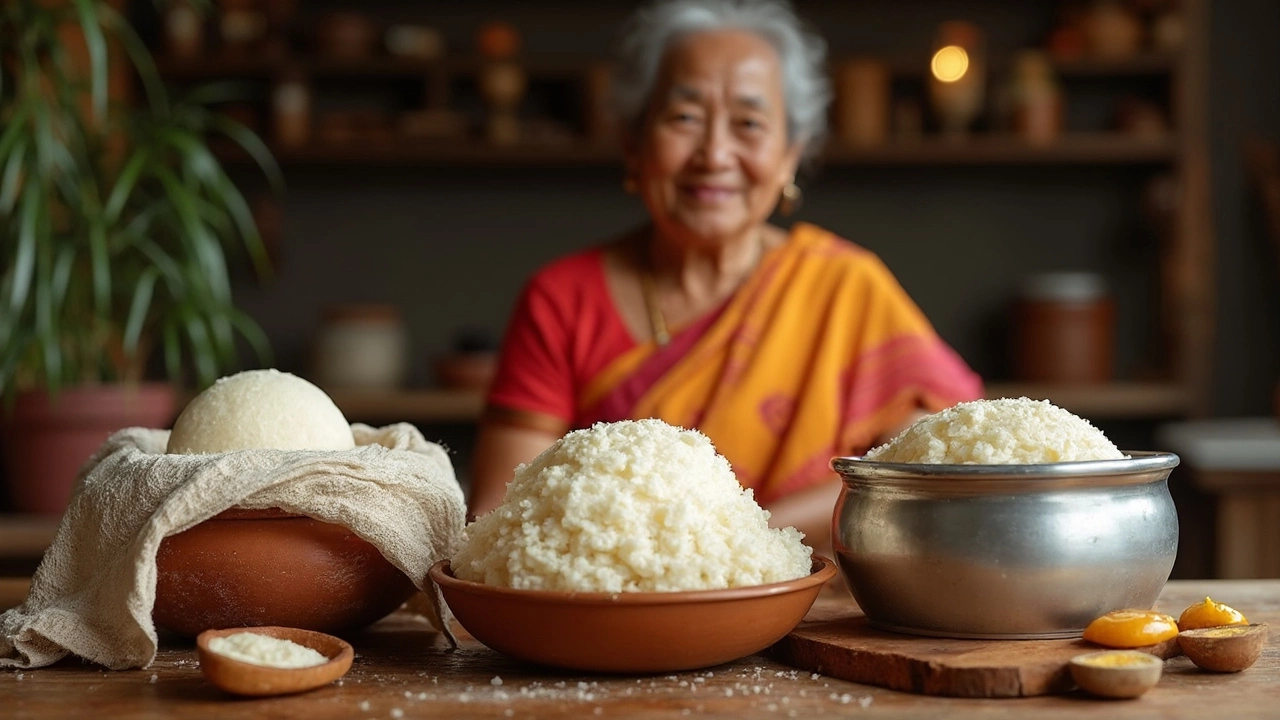How to Quickly Ferment Idli Batter Without Yeast
 Feb, 11 2025
Feb, 11 2025
If you're in a rush to make idli batter but find yourself without yeast, don't worry. Speeding up the fermentation process can be done with a few simple tricks—no need for special equipment or ingredients. It all starts with understanding the basics of fermentation.
Temperature is your friend here. Keeping your batter warm can significantly speed up the process. Place the batter in an oven with just the light on, or wrap it up in a cozy blanket. It’s like giving your batter a warm hug—who wouldn’t rise to that occasion?
Understanding Fermentation
So, what really happens in the magic process of fermenting idli batter? It's all about nurturing the right environment for natural microbes like bacteria and yeast—yes, even without adding them directly. These tiny living organisms are already on the grains and in the air, ready to get to work.
The core idea here is that fermentation is a natural process where these microbes break down sugars into acids, gases, or alcohol. In the case of idli batter, it creates carbon dioxide, making the batter rise and giving idlis their signature fluffiness. Fast idli fermentation is a bit of a balancing act: creating the right conditions so the good microbes thrive but aren't outpaced by harmful ones.
Temperature is Key
The warmer it is, the faster your fermentation will go. Aim for a cozy 30-32°C (86-90°F). At these temperatures, your batter should start bubbling happily. This is why folks in chilly regions often struggle—it’s not you, it’s your climate! But don’t worry, there are easy workarounds which we'll discuss later.
Understanding pH Levels
If you’re into details, here’s something cool: pH levels drop as fermentation proceeds. The batter starts around neutral pH 7 but drops to about pH 4-4.5, which is perfect for idlis. This acidity also helps preserve the batter for a few days without spoiling.
Why Yeast Isn't a Must
While commercial yeast can speed things up, it often messes with the taste and texture. Traditional techniques harness natural wild yeast, which is already in the air. This method keeps your idlis light, airy, and rich in their natural flavor.
Role of Temperature
Temperature plays a crucial role in fermenting idli batter fast, especially if you're skipping the yeast. The warmer the environment, the quicker the natural fermentation process kicks in. Think of warmth as the magic ingredient that sparks those beneficial bacteria into action.
The Ideal Temperature
The sweet spot for fermenting idli batter is around 30 to 35°C (86 to 95°F). Like Goldilocks, you want it just right—not too cold or too hot. Too low, and you’ll be waiting forever. Too high, and you could end up with a sour, over-fermented mess.
How to Maintain Warmth
Here are some easy ways to keep your batter cozy:
- Oven Trick: Place the batter bowl in an oven with just the light on. The light alone generates enough warmth.
- Blanket Method: Wrap the bowl in a blanket or thick towel. Surprisingly effective and it feels kinda homey.
- Near Appliance: Leave the bowl near a warm appliance in the kitchen, like the fridge (not inside, just next to it) or your rice cooker.
Each of these methods creates an ideal environment for fast idli fermentation without adding any fuss.
Mind the Seasons
Seasonal changes can affect fermentation times too. In winter, you may notice the process takes longer, so try these warmth-boosting tricks to stay on track. During summer, things tend to ferment faster, but be mindful of preventing it from getting too warm.
By tweaking the temperature, you’re essentially giving your idli batter a little nudge to ensure speedy fermentation. A few degrees make all the difference when you’re in a rush to whip up those fluffy delights.

Ingredient Optimization
When it comes to making sure your idli batter ferments quickly without yeast, the ingredients you use can make a huge difference. Let's break down some essentials that will help you out.
Quality Matters
First up, always aim for quality ingredients. Use a combination of parboiled rice and urad dal. Typically, a ratio of 3:1 (rice to dal) gives a soft and fluffy idli. Fresh urad dal is particularly important. Old or stale dal might not bring the same level of fermentation action because its natural enzymes could have weakened.
The Role of Fenugreek
A small addition of fenugreek seeds can work wonders. About a teaspoon of these seeds soaked with the dal can enhance the fermentation process. They're like a natural booster without any artificial stuff. Fenugreek also gives a slight golden hue and amplifies flavor.
Add a Pinch of Salt
Add salt after grinding and mixing the batter. Not only does it help in improving flavor, but salt also assists in the fermentation. However, a pinch is enough; adding too much could actually inhibit the process.
The Power of Aval (Flattened Rice)
Another hack is to include a handful of flattened rice or aval while soaking your rice. This can make your idlis super soft, kicking the fermentation even a notch higher. Aval absorbs water, and this extra hydration in the mix promotes better microbial activity.
Practical Storage Tips
Getting the ferment idli batter just right often boils down to how you store it. Let's get into some useful tips to ensure your batter ferments like a pro.
Choose the Right Container
First off, make sure you're using a large enough container since the batter expands as it ferments. Ideally, fill only about two-thirds of the container. This leaves ample space for expansion and you won't end up with a batter explosion in your kitchen!
Seal Loosely
A tight seal isn't necessary here. Instead, cover the container with a loose lid or even a cloth. This allows the natural fermentation gases to escape without building pressure. If your kitchen is on the cooler side, consider covering it with a warm cloth.
Location Matters
Location, my friend, is everything. Picking a spot that's warm and cozy can cut down the fermentation time. A neat trick is to place your container in the oven with just the light on for some gentle warmth. Remember, don't actually turn on the oven.
A Dash of Pre-Fermented Batter
Here’s a neat hack: if you've got a previous batch of fermented batter hanging around, add a spoonful to kickstart the process. It acts like a natural leavening agent, thanks to the already active microbes.
Monitor Consistently
Keep an eye on your fermenting progress. Usually, 8 to 12 hours is a good time frame, but depending on your local climate, it could take longer or shorter. Once it doubles in volume and has a slightly sour smell, you're in good shape to enjoy those idlis.
| Temperature | Fermentation Time |
|---|---|
| 25°C (77°F) | 12-14 hours |
| 30°C (86°F) | 8-10 hours |